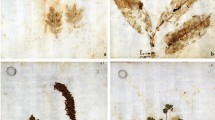Abstract
Three-lobed sage is here claimed as being, most likely, a part in the sage of the ancient and medieval texts not a mere substitute for S. officinalis. The traditional uses recently discovered in Spain and Madeira are here published for the first time and compared with the data available from the Eastern Mediterranean region.
Zusammenfassung
La salvia trilobulada es reivindicada como una muy probable parte de la salvia de los textos antiguos y medievales, y no como un mero sustituyente de Salvia officinalis. Los usos tradicionales recientemente descubiertos en España sepresentan aquí por primera vez y se comparan con los datos disponibles de la Región Mediterránea Oriental.
Similar content being viewed by others
Literature Cited
Baser, K., G. Honda, and W. Miki. 1986. Herb drugs and herbalists in Turkey. Institute for the study of languages and cultures of Asia and Africa, Tokyo.
Berendes, J. 1988. Des pedanios dioskurides aus anazarbos. arzneimittellehre. Akademische Druck, Graz.
Bezanger-Beauquesne, L., M. Pinkas, M. Torck, and F. Trotin. 1980. Plantes médicinales des régions tempérées. Maloine, Paris.
Boissier, E. 1879. Flora Orientalis. Volume 4. H. Georg, Basilea.
Boulos, L. 1983. Medicinal plants of North Africa. Reference Publications, Algonac.
Bournot, K. 1968. Ätherische Öle. J. Cramer, Lehre.
Coutinho, A. X. 1974. Flora de Portugal. J. Cramer, Lehre.
Cube, J. 1485. Hortus sanitatis. Peter Schöffer, Mainz.
Desfontaines, L. 1830. Caii Plinii secundi historiae naturalis libri XXXVII. Vol. 7. N. Lemaire, Paris.
Diaz, J. 1988. Teofrasto, historia de las plantas. Gredos, Madrid.
Dierbach, J. 1969. Die Arzneimmitel des Hippokrates. Georg Olms, Hildesheim.
Feinbrun-Dothan, N. 1978. Flora Palaestina, 3 text, Ericaceae to Compositae. The Israel Academy of Sciences and Humanities, Jerusalem.
Frisk, G. 1949. A Middle English translation of macer floridus de Viribus Herbarum. Almquist and Wiksells, Uppsala.
Gattefossé, J. 1921. Les plantes dans la thérapeutique indigéne au Maroc.In E. Perrot and L. Gentil, eds. Sur les productions végétales du Maroc p. 73–113. Office National des Matiéres premiéres végetales, Paris.
Gerarde, J. 1633. The herball or general historie of plantes. Adam Ship, London.
Greuter, W., H.M. Burdet, and G. Long. 1986. Med-Checklist, 3, Dicotyledones (Convolvulaceae-La- biatae). Conservatoire et Jardin botaniques, Geneva.
Grieve, M. 1931. A modern herbal. Jonathan Cope, London.
Gunther, R. 1968. The Greek herbal of Dioscorides. Hafner, London.
Halacsy, E. 1902. ConspectusfloraeGrecae.Vol.II. Wilhelm Engelmann, Leipzig.
Hanson, W., and G. Hocking. 1957. Garden sage. Economic Botany 11: 64–74.
Hartwell, J. 1982. Plants used against cancer, a survey. Quarterman, Lawrence.
Hedge, I. 1972. Salvia L.In T. G. Tutin et al., eds. Flora Europaea. Vol. 3: 188–192. Cambridge University Press, Cambridge.
Huxley, A., and W. Taylor. 1984. Flowers of Greece and the Aegean. Chatto & Windus, London.
Karim, F., and S. Quraan. 1986. Medicinal plants of Jordan. Centre for Jordanian Studies, Irbid.
Laguna, A. 1566. Pedacio Dioscórides Anazarbeo, acerca de la materia medicinal y de los venenos mortíferos. Mathias Gast, Salamanca.
Lippert, W. 1979. Zur Kenntnis vonSalvia SektionSalvia im Westlichen Mittelmeergebiet. Mitteilun- gen Bot. München, 15: 397–423.
Loret, V. 1975. La flore pharaonique. Georg Olms, Hildesheim.
Loudon, J. 1841. An encyclopaedia of plants. Longman, London.
Menezes, C. 1914. Flora do Archipelago da Madeira. Junta Agricola da Madeira, Funchal.
Miller, P. 1754. The Gardeners dictionary. Abriged from the last folio edition. John and James Rivington, London.
Moldenke, H., and A. Moldenke. 1986. Plants of the Bible. Dover, New York.
Palevitch, D., Z. Yaniv, A. Dafni, and J. Friedman. 1986. Medicinal plants of Israel: an ethnobotanical survey.In L. Craker and J. Simon, eds. Herbs, spices, and medicinal plants p. 281–345. Oryx Press, Phoenix.
Parkinson, J. 1629. Paradisi in sole terrestris. London [1904].
Pignatti, S. 1982. Flora d’ltalia. Edagricole, Bologna.Polunin, O. 1980. Flowers of Greece and the Balkans. Oxford University Press, Oxford.
Putievsky, E., and U. Ravid. 1985. Selection and cultivation ofSalvia fruticosa Mill. (SynS. triloba) from wild populations in Israel. Eucarpia 1: 87–94.
Ravid, U., and E. Putievsky. 1985. Essential oils of Israeli wild species of Labiatae.In A. Baerheim and J. Scheffer, eds. Essential oils and aromatic plants p. 155–161. Martinus Nijhoff, Dordrecht.
Renaud, H., and S. Colin. 1934. Glossaire de la matiére médicale Marocaine. Institut des Hautes Études Marocaines, Paris.
Rosúa, J. L., and G. Blanca. 1986. Revision del generoSalvia L. (Lamiaceae) en el Mediterráneo Oc- cidental: La sectiónSalvia. Acta Botánica Mala- citana 11: 227–272.
Sadek, M. M. 1983. The Arabic materia medica of Dioscorides. Les Editions du Sphynx, St-Jean-Chrysostome.
Sibthorp, J., andJ. Smith. 1806. Flora Graeca prodromus. Vol. 1. Richard Taylor, London.
Simon, J., A. Chadwick, andL. Craker. 1984. Herbs, an indexed bibliography 1971-1980. Elsevier, Amsterdam.
Thorndike, L. 1946. The herbal of Rufinus. University of Chicago Press, Chicago.
Wildeman, E. 1950. Notes pour l’histoire de la bo- taniquie et de l’horticulture en Belgique. Memoires de l’académie Royale de belgique, 2. Serie 25: 1- 832.
Willkomm, M. 1893. Supplementum prodromi florae Hispanicae. Schweizerbart, Stuttgart.
Yaniv, Z., A. Dafni, andD. Palevitch. 1982. Labiatae as medicinal plants in Israel.In N. Margaris, A. Koedam, and D. Vokou, eds. Aromatic plants: basic and applied aspects p. 265–269. Martinus Nijhoff, The Hague.
Zohary, M. 1983. Pflanzen der Bibel. Calwer Verlag, Stuttgart.
Author information
Authors and Affiliations
Rights and permissions
About this article
Cite this article
Rivera, D., Obon, C. & Cano, F. The Botany, History And Traditional Uses Of Three-Lobed Sage (Salvia Fruticosa Miller) (Labiatae). Econ Bot 48, 190–195 (1994). https://doi.org/10.1007/BF02908216
Received:
Accepted:
Issue Date:
DOI: https://doi.org/10.1007/BF02908216




